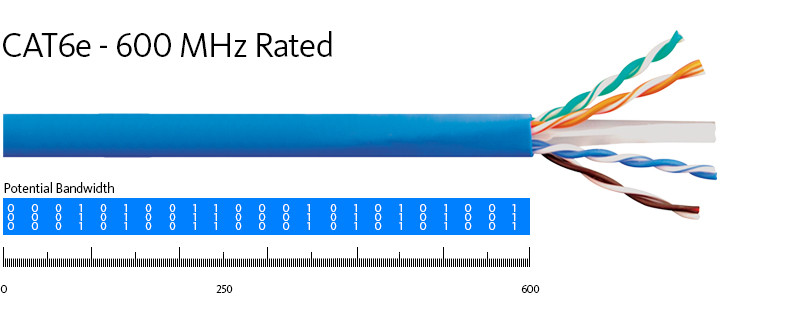Category 6 (CAT6) and Category 6e (CAT6e) cables are both popular choices for Ethernet networks, but understanding their differences is crucial for optimal network performance. While both are designed for high-speed data transmission, key distinctions in their specifications and industry recognition can impact your network infrastructure decisions. This article breaks down the features of CAT6 and CAT6e to help you choose the right cable for your needs.
Delving into CAT6 Specifications
CAT6 cable emerged as an industry standard to support Gigabit Ethernet (1000BASE-T) which required higher frequency transmission. Standardized by the Telecommunications Industry Association (TIA), CAT6 cables are engineered to operate at a frequency of 250 MHz. To achieve this enhanced performance compared to previous categories like CAT5e, CAT6 cables incorporate several design improvements. These include thicker gauge wires, increased shielding, and tighter wire twists per inch. These enhancements minimize signal loss and reduce interference, ensuring reliable data transfer speeds of 1 Gigabit per second (Gbps) over distances up to 100 meters (328 feet). While primarily designed for Gigabit Ethernet, CAT6 can also support 10 Gigabit Ethernet speeds over shorter distances, typically up to 50 meters (180 feet).
 CAT6e cable rated at 600 MHz frequency, compared to CAT6 cable. Image showcasing the enhanced performance of CAT6e network cable.
CAT6e cable rated at 600 MHz frequency, compared to CAT6 cable. Image showcasing the enhanced performance of CAT6e network cable.
Exploring CAT6e Capabilities
CAT6e is often presented as an augmented version of CAT6, aiming to offer enhanced performance. A primary advertised benefit of CAT6e is its increased frequency range, often quoted at 600 MHz, doubling the 250 MHz specification of CAT6. This higher frequency capability is intended to provide even better performance and potentially support higher data rates. However, a critical point to note is that unlike CAT6, CAT6e is not a standard recognized by the TIA or other industry standardization bodies. Instead, CAT6e is more of a manufacturer-defined specification, often marketed as a premium upgrade to CAT6. Some CAT6e cables, particularly those with grounded foil shielding, claim to support 10 Gigabit Ethernet speeds over the full 100-meter distance, which is a potential advantage over standard CAT6.
CAT6 vs CAT6e: Key Differences Summarized
| Feature | CAT6 | CAT6e |
|---|---|---|
| Industry Standard | TIA Standardized | Not TIA Standardized |
| Frequency Range | Up to 500 MHz (ICC cables), 250 MHz Standard | Up to 600 MHz (ICC cables), No official standard |
| Gigabit Ethernet | Yes (100m / 328ft) | Yes (100m / 328ft) |
| 10 Gigabit Ethernet | Yes (up to 50m / 180ft) | Yes (up to 100m / 328ft, with shielding claims) |
| Common Applications | Home, Office Networks, Phone Lines | Data Centers, demanding network environments |
In conclusion, while CAT6e may offer technically superior specifications like a higher frequency range in some manufacturer offerings, it lacks the industry-standard backing of CAT6. For most standard network applications in homes and offices, CAT6 provides a reliable and cost-effective solution. CAT6e might be considered for environments like data centers or situations where future-proofing and potentially higher bandwidth over longer distances are prioritized, but it’s essential to verify manufacturer claims and understand that it’s not a formally recognized industry standard. Always ensure your chosen cable meets the specific requirements of your network infrastructure.
